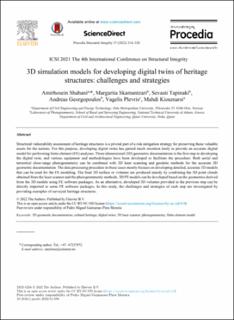| dc.contributor.author | Shabani, Amirhosein | |
| dc.contributor.author | Skamantzari, Margarita | |
| dc.contributor.author | Tapinaki, Sevasti | |
| dc.contributor.author | Georgopoulos, Andreas | |
| dc.contributor.author | Plevris, Vagelis | |
| dc.contributor.author | Kioumarsi, Mahdi | |
| dc.date.accessioned | 2022-08-02T08:54:17Z | |
| dc.date.available | 2022-08-02T08:54:17Z | |
| dc.date.created | 2022-04-22T12:08:15Z | |
| dc.date.issued | 2022-02-22 | |
| dc.identifier.citation | Procedia Structural Integrity. 2022, 37 314-320. | en_US |
| dc.identifier.issn | 2452-3216 | |
| dc.identifier.uri | https://hdl.handle.net/11250/3009733 | |
| dc.description.abstract | Structural vulnerability assessment of heritage structures is a pivotal part of a risk mitigation strategy for preserving these valuable assets for the nations. For this purpose, developing digital twins has gained much attention lately to provide an accurate digital model for performing finite element (FE) analyses. Three-dimensional (3D) geometric documentation is the first step in developing the digital twin, and various equipment and methodologies have been developed to facilitate the procedure. Both aerial and terrestrial close-range photogrammetry can be combined with 3D laser scanning and geodetic methods for the accurate 3D geometric documentation. The data processing procedure in these cases mostly focuses on developing detailed, accurate 3D models that can be used for the FE modeling. The final 3D surface or volumes are produced mainly by combining the 3D point clouds obtained from the laser scanner and the photogrammetric methods. 3D FE models can be developed based on the geometries derived from the 3D models using FE software packages. As an alternative, developed 3D volumes provided in the previous step can be directly imported to some FE software packages. In this study, the challenges and strategies of each step are investigated by providing examples of surveyed heritage structures. | en_US |
| dc.description.sponsorship | This work is a part of the HYPERION project. HYPERION has received funding from the European Union’s Framework Programme for Research and Innovation (Horizon 2020) under grant agreement No 821054. The contents of this publication are the sole responsibility of OsloMet and NTUA and do not necessarily reflect the opinion of the European Union. | en_US |
| dc.language.iso | eng | en_US |
| dc.publisher | Elsevier | en_US |
| dc.relation.ispartofseries | Procedia Structural Integrity;Volume 37, 2022 | |
| dc.rights | Attribution-NonCommercial-NoDerivatives 4.0 Internasjonal | * |
| dc.rights.uri | http://creativecommons.org/licenses/by-nc-nd/4.0/deed.no | * |
| dc.subject | 3D geometric documentation | en_US |
| dc.subject | Cultural heritage | en_US |
| dc.subject | Digital twins | en_US |
| dc.subject | 3D laser scanners | en_US |
| dc.subject | Photogrammetry | en_US |
| dc.subject | Finite element models | en_US |
| dc.title | 3D simulation models for developing digital twins of heritage structures: challenges and strategies | en_US |
| dc.type | Peer reviewed | en_US |
| dc.type | Journal article | en_US |
| dc.description.version | publishedVersion | en_US |
| dc.rights.holder | © 2022 The Authors | en_US |
| cristin.ispublished | true | |
| cristin.fulltext | original | |
| cristin.qualitycode | 1 | |
| dc.identifier.doi | https://doi.org/10.1016/j.prostr.2022.01.090 | |
| dc.identifier.cristin | 2018382 | |
| dc.source.journal | Procedia Structural Integrity | en_US |
| dc.source.volume | 37 | en_US |
| dc.source.pagenumber | 314-320 | en_US |
| dc.relation.project | Horisont 2020: EC/H2020/821054 | en_US |

